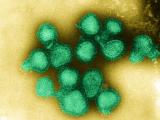Jan 6, 2011 (CIDRAP News) In the face of localized shortages of seasonal influenza vaccine and rising cases and deaths, British health officials told doctors today that they can use stockpiled monovalent 2009 H1N1 vaccine to immunize high-risk patients, according to media reports.
Dr Sally Davies, England's chief medical officer, said the government will release 12.7 million doses of Pandremix H1N1 vaccine, the Guardian reported. In 2010 UK officials faced tough criticism from some politicians for spending money on H1N1 vaccine stockpiles.
The move came as United Kingdom health officials released the latest flu surveillance findings, which show that flu indicators are still well above baseline, with some slightly lower for the week ending Dec 26. The health department urged people to interpret the numbers with caution, because they reflect information collected during the Christmas holiday week, when many schools were closed and many doctor's offices were open only part of the week.
A surge in flu activity, most of it caused by the 2009 H1N1 virus, has fueled demand for the seasonal flu vaccine, which covers the virus. The UK health department admitted there were shortages in some areas, and some doctors said policies preventing the sharing of vaccine stocks were contributing to availability problems, according to a report today in Pulse, a weekly medical publication.
The health department said it has asked vaccine manufacturers if they can supplement the 14 million doses the government has already ordered and distributed to UK medical practices, according to the Pulse report.
In another development, the National Health Service is expanding its extracorporeal membrane oxygenation (ECMO) treatment capacity to help hospitals manage the most severely ill 2009 H1N1 patients, according to today's Guardian report. ECMO is a sophisticated heart-lung-bypass procedure designed to allow flu-damaged lungs to heal.
In December the NHS increased the number of ECMO treatment beds from 5 to 22 at seven hospitals, and it plans to add 4 additional beds with the possibility of more at hospitals that are canceling surgeries because of the surge in flu cases, the Guardian reported.
In its surveillance update today, the UK's Health Protection Agency (HPA) said doctor's visits for flu-like illnesses decreased in England and Scotland, were stable in Wales, and increased in Northern Ireland during the week that ended Dec 26. The HPA received reports of 13 acute respiratory illnesses outbreaks, 3 in primary schools, 7 in prisons, and 2 in care homes. In England 70% of respiratory specimens at outpatient clinics were positive for influenza, most of it the 2009 H1N1 virus, with about a third of it influenza B.
As of Jan 5 the HPA said it has received 50 flu fatality reports, 45 of them linked to the 2009 H1N1 virus. The deaths mainly occurred in younger adults and children, with only four in patients older than 64. Among 48 patients whose previous medical status was known, 33 had underlying conditions. Of 39 fatal cases with known vaccination status, 36 patients had not received the seasonal flu vaccine as of 2 weeks before illness onset, and 33 of 34 didn't receive the monovalent H1N1 vaccine last season.
Preliminary vaccine uptake data suggest that 70% of people over age 64 have received the seasonal flu vaccine and about 45% of people younger than 65 in risk groups have been immunized, the HPA said.
In a related report in Eurosurveillance today that included more detailed virological data on the UK's flu epidemic, HPA officials said analysis shows only minor genetic drift, compared with earlier 2009 H1N1 viruses, which they said isn't surprising. Analysis of viruses from severe and fatal cases so far shows no unique mutations.
Since October 2010 laboratories have identified six cases of oseltamivir (Tamiflu) resistance, of which only one patient had known exposure to the medication. Four cases were in hospitalized patients, three before treatment and one after receiving the drug.
The HPA experts said influenza, the circulation of other respiratory infections such as respiratory syncytial virus, and particularly cold weather have put pressure on the UK's health system. They said illness patterns are similar to those during the pandemic waves, except that the highest rates of infections are being seen in the 15- to 44-year-old age group, which has also had the highest rates of hospitalizations and deaths. During the pandemic infection rates were highest in children ages 5 to 14.
The experts wrote that most of the severely ill patients and those who have died had not been vaccinated and did not receive early antiviral treatment, which they said should serve as a warning for other European countries to shore up flu-prevention measures for high-risk groups.
See also:
Jan 6 Guardian story
Jan 6 HPA update
Jan 6 Eurosurveillance report



















